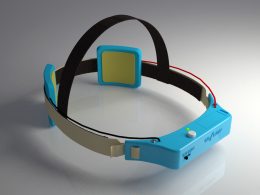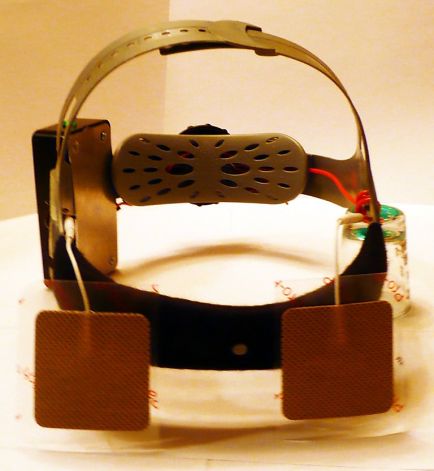Difference between revisions of "GoFlow"
(a correction) |
(Main Characteristics) |
||
| Line 36: | Line 36: | ||
== Main characteristics == | == Main characteristics == | ||
| + | |||
| + | GoFlow should have caused a "flow state" to its users. This is the state of intense concentration and appears among artists, athletes or workers.<ref name="A brain charger"/> | ||
| + | |||
| + | The manufacturers of GoFlow intended to develop the first low-cost commercial tDCS device.<ref name="A brain charger"/> | ||
=== Purpose === | === Purpose === | ||
| − | The main purpose is to enhance skills of its users by publicly available tDCS device. | + | The main purpose is to enhance skills of its users by low-cost and publicly available tDCS device. |
=== Company & People === | === Company & People === | ||
Revision as of 14:39, 21 November 2016
| GoFlow | |
|---|---|

|
|
| Category | Transcranial direct-current stimulation |
| Developer | GoFlow |
| Announced | March 2012 [1] |
| Released | Developers:
Consumers: project cancelled [2] |
| Price | 99 USD (March 2012)[3] the device was never shipped |
| Max output | 5 mA5 T 0.005 A [4] |
| Session duration | 18001,800 s 30 minute [5] |
| Scalp location | unspecified |
| Weight | g |
| Controls |
N/A |
| Data available | |
| Risk factor | |
| Medical prescription | No |
| http://www.diytdcs.com/tag/goflow/ | |
GoFlow should be small head mounted device which provides transcranial direct-current stimulation. The device was developed by students at the University of Michigan and was announced as first direct-to-consumer tDCS device. It was, however, never shipped due to FDA concerns.[1]
GoFlow consists of head-mounted device, which includes two sponge electrodes, potentiometer, 9 V battery[5] and 5 mA safety fuse[4]. It should have been shipped with the map of brain regions, in order to let users know the proper placement of electrodes.[5]
Contents
Main characteristics
GoFlow should have caused a "flow state" to its users. This is the state of intense concentration and appears among artists, athletes or workers.[4]
The manufacturers of GoFlow intended to develop the first low-cost commercial tDCS device.[4]
Purpose
The main purpose is to enhance skills of its users by low-cost and publicly available tDCS device.
Company & People
GoFlow was originally developed by students at the University of Michigan but it was never shipped.
- Matt Sornson - the co-founder of GoFlow
- Nick Woodhams - the co-founder of GoFlow[1]
- Benjamin Syzek - Ph.D neuroscience student at Michigan State University [6]
Important Dates
- spring 2012 - the new device was announced and the Kickstarter campaign began
- May 2012 - the Kickstarter campaign was delayed and later cancelled because of FDA involvement
- early 2013 - the developers give up the development of an available tDCS device and sold the project to the Foc.us company
- summer 2013 - the first device tDCS which was produced by Foc.us was released[1]
Enhancement/Therapy/Treatment
Ethical & Health Issues
There are several ethical and health issues linked with tDCS in general or DTC tDCS specifically.
Public & Media Impact and Presentation
Several authors pointed out that the presentation of the project was not really professional. Tim Verry from PC Perspectives claimed:
Personally, statements such as "our tDCS kit is the shit" and "get one of the first β1's and will help us develop β2" on the web[site] are not exactly instilling confidence to me, but if you're big into the early adopter adventure, GoFlow may have something for you to test.[7]
and Christopher Mims at MIT Technology Review argued:
Given the (lack of) production values in their promotional video, I’m not all that reassured by the included testimonial from a neuroscience graduate student. [8]
Public Policy
Related Technologies, Projects or Scientific Research
References
- ↑ 1.0 1.1 1.2 1.3 WEXLER, Anna. A pragmatic analysis of the regulation of consumer transcranial direct current stimulation (TDCS) devices in the United States. Journal of Law and the Biosciences [online]. 2015, Oct 12. Available online at: http://jlb.oxfordjournals.org/content/2/3/669.full.pdf+html (Retrieved 1st November, 2016).
- ↑ JOHN. News from GoFlow! Good and Bad. DIY tDCS [online] 2013, Jun 7. Available online at: http://www.diytdcs.com/2013/06/news-from-goflow-good-and-bad/ (Retrieved 1st November, 2016).
- ↑ JOHN. GoFlow: Learn Faster. DIY tDCS [online]. 2012, Mar 17. Available online at: http://www.diytdcs.com/2012/03/goflow-learn-faster/ (Retrieved 21st November, 2016).
- ↑ 4.0 4.1 4.2 4.3 VANCE, Ashlee. A brain charger for $100 - but will it work?. SFGate [online]. 2012, Mar 25. Available online at: http://www.sfgate.com/business/article/A-brain-charger-for-100-but-will-it-work-3432153.php#ixzz25TjyRopo (Retrieved 21st November, 2016).
- ↑ 5.0 5.1 5.2 ANTHONY, Sebastian. GoFlow: a DIY tDCS brain-boosting kit. ExtremeTech [online]. 2012, Mar 9. Available online at: http://www.extremetech.com/extreme/121861-goflow-a-diy-tdcs-brain-boosting-kit (Retrieved 21st November, 2016).
- ↑ WEBSTER, Andrew. GoFlow kit lets you build your own brain stimulation machine for $99. The Verge [online]. 2012, Mar 14. Available online at: http://www.theverge.com/2012/3/14/2871740/goflow-kit-tdcs-brain-stimulation (Retrieved 21st November, 2016).
- ↑ VERRY, Tim. GoFlow To Offer $99 tDCS Brain Augmentation Kit. PC Perspective [online]. 2012, Mar 12. Available online at: https://www.pcper.com/news/General-Tech/GoFlow-Offer-99-tDCS-Brain-Augmentation-Kit (Retrieved 21st November, 2016).
- ↑ MIMS, Christopher. DIY Kit Overclocks Your Brain With Direct Current. MIT Technology Review [online]. 2012, Mar 09. Available online at: https://www.technologyreview.com/s/427177/diy-kit-overclocks-your-brain-with-direct-current/ (Retrieved 21st November, 2016).
